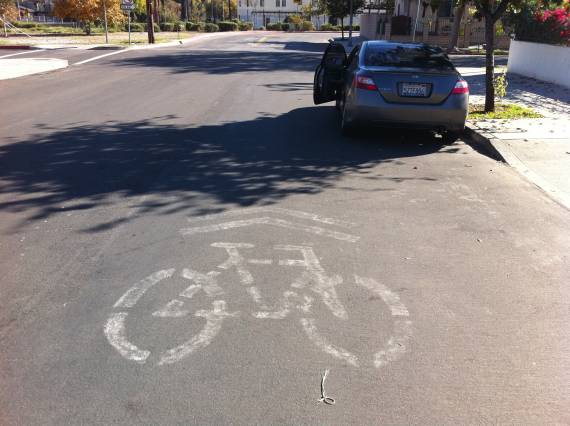
Yesterday, Carter Rubin and I were in Northeast L.A. on our way to a meeting at Occidental College and we had a chance to stop in and visit with Josef Bray-Ali st the Flying Pigeon Bike Shop (see ad on the right). I commented that the "D.I.Y. Sharrows" that appeared along some local streets connecting the Gold Line Station with Figueroa street were finally taken up. LADOT had promised to remove the road markings when they were put up, one year and a couple of days ago, but Bray-Ali pointed out I was wrong. "They're still there, they're just faded."
And he's right. A quick trip down the block showed Sharrows as far as the eye could see. While we could use this opportunity to roll our eyes at LADOT and Bureau of Street Services for not being organized enough to blast these Sharrows off the street, it provides a chance to reflect that our city has made some real strides towards livability.
When these Sharrows were put down, they weren't just a slap in the face to the city for failing to follow through on their promise to bring Sharrows to Los Angeles, but also a challenge for the city to finally get serious about starting to make the city a safer place to bike. While I wouldn't say that LADOT or the city has embraced the challenge, a lot has happened since then.
Bike lanes have sprouted in South L.A., the San Fernando Valley and, last week, on York Boulevard just a couple of miles from where the D.I.Y. Sharrows sit. While it's still eye-rolling that they're making Cafe de Leche' pay for it themselves, the city agreed to let them "pilot" a bike corral. Official Sharrows have popped up on six streets. Heck, even the LAPD is starting to treat cyclists like human beings and not like kids playing with toys. Last, while it's far from perfect, the Give Me 3 campaign has been fun and increased visibility.
I'm not saying Los Angeles doesn't have a long way to go to join Portland, Minneapolis, Long Beach, New York or San Francisco; but compared to the first two years Streetsblog published; 2010 has proved itself to be a year where some things were finally getting done.
And, cyclists didn't have to do it all themselves. Well, at least most of the time.





